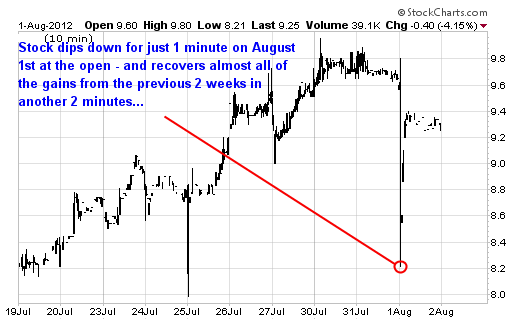Sometime soon, one of your stock holdings is going to crash…hard.
What will you do?
It’s an important question today especially, because it’s earnings season. And for most investors that means shares of their stocks are jumping around like beach balls.
If you have a lot of your portfolio allocated to small-cap stocks as I do, the swings can be potentially gut-wrenching when they don't go as you'd wish (let's face it, things don't always go as planned).
But amid the craziness there are often reasons to be calm when your stock tanks. If you're in the right stocks to begin with, often times the volatility amounts to a blip on the screen that is nothing more than a short-term market inefficiency. These types of blips happen all the time with thinly-traded small cap stocks.
In the past week, I've seen this time and time again, and thus far the vast majority of stocks I cover have recovered from their 'crashes'. Take a look at this example of a micro cap stock that had a trading range of $1.60 yesterday – a massive 17% of the stock's price at the market open.

The chart above shows that this stock spiked down to $8.21 early in the morning, only to recover most of that drop within the next hour. Taking into account three things, this drop was a great buying opportunity for anybody who was paying attention and no cause for concern for existing shareholders.
(I've had to hide the name since this stock is in my Small Cap Investor Pro portfolio, and access to its name and research report is only available to subscribers.)
So what are these three things?
First, I'm confident in the stock because I've completed my due diligence and maintain close coverage of the company. Since I recommended it 8 months ago, subscribers are up 76% and I think it's going higher.
Lesson #1: Do your homework, then keep doing it because things can change…or not. The only way you'll know the difference, and be prepared to act, is if you stay on top of things.
Second, there was no news that caused the drop.
Lesson #2: Small cap stocks often trade in an inefficient market, where there is an imbalance between buyers and sellers. This alone is NOT cause for concern, but rather an opportunity for astute investors and one reason many chose to focus only on small and micro cap stocks.
And third, this stock trades only around 50,000 shares daily. Most transactions are for less than 2,000 shares, which means there can be a big 'bid' and 'ask' spread at any given moment.
Lesson #3: Volume matters. Understanding how volume and liquidity affect stock price movements can help you get the best price when buying and selling stocks. And it also helps you understand why a 10% 'gap' move can mean absolutely nothing in the big picture with a quality small-cap stock. Remember to use limit orders, not market orders, to get the price you want.
Market volatility can be intense at any time of year, and especially so during earnings season. Maintaining discipline is the key.
And the above three lessons can help you understand if your small-cap stocks are actually crashing, or if they're just bouncing around.
Good Investing,
Tyler Laundon, MBA

 Facebook
Facebook
 Twitter
Twitter